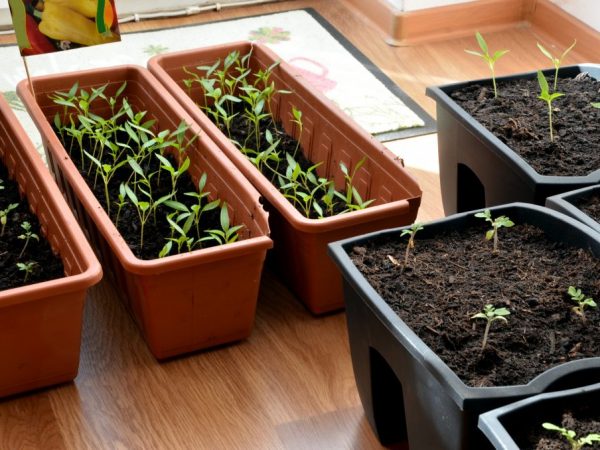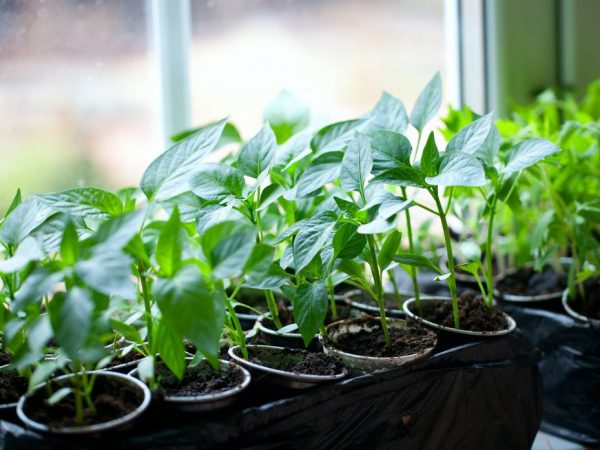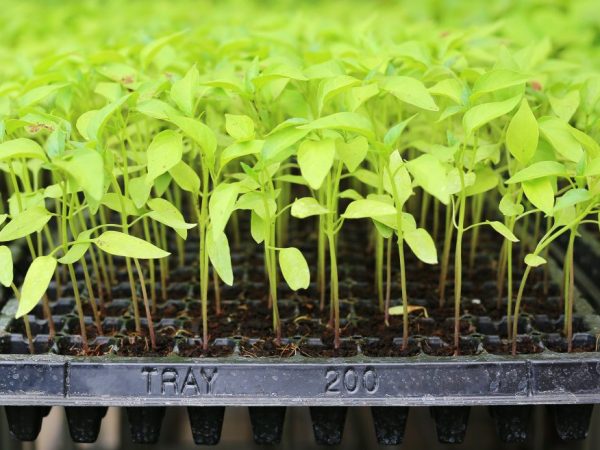Rules for growing pepper seedlings at home
correct cultivation of pepper seedlings is the key to successful cultivation of pepper. In order for the seedlings on the windowsill to grow healthy, certain rules must be followed. The article provides step-by-step instructions for growing pepper seedlings.

Rules for growing pepper seedlings at home
Soil preparation
Growing pepper seedlings at home involves the choice of soil for sowing seeds.
Each individual crop has its own requirements for the soil and its composition. The soil mixture for peppers must meet the following requirements:
- Lightweight, well-drained with a loose structure so that water can easily pass through and not stagnate.
- Nutritious, with an optimal amount of trace elements (N-0.2%, P-0.2%, K-2%) and the presence of magnesium, calcium, manganese and iron.
- Neutral in acidity, with a pH of 5-7.
- Should contain live microflora and organic matter.
Preparation of soil mixture
You can buy ready-made soil mixture, but it will not be difficult to prepare it yourself. To do this you need:
- sod land 3 kg;
- low peat 3 kg;
- sand 3 kg;
- ash 300 g;
- vermiculite 0.5 l.
All ingredients must be mixed thoroughly. This mixture is ideal for growing pepper seedlings at home.
The soil mixture must be disinfected to exclude infection by pathogens or pests. This can be done in two ways:
- Thermal: the soil is kept in the oven at a temperature of 90 ° C for 30-40 minutes. or spill the soil with boiling water.
- Chemical: for disinfection use potassium permanganate (1 g per 1 liter of water) or hydrogen peroxide (1 tbsp. L. Per 1 liter of water). The soil mixture is poured with the prepared solution and allowed to dry.
By treating the soil in this way, you can effectively protect young plants.
Selection of containers
Any available containers are suitable for planting. These can be plastic containers, balcony boxes, plastic cups, special cassettes, peat-paper cups. Peat pots are especially convenient for sowing seedlings; together with them, grown plants can be planted in a permanent place without unnecessary trauma. They can be purchased at gardening stores, but you can also make your own.
To do this, use the following ingredients:
- peat 700 g;
- humus 300 g;
- mullein 100 g;
- slaked lime 30 g.
Peat needs to be sieved, the mullein is poured with hot water (250 ml). All components are thoroughly mixed. Water is added in small portions until a thick slurry is formed, it should not spread. Peat pots are formed with two glass or plastic glasses. The inner walls of one glass are laid out with the resulting mixture, and the second is inserted into the middle. Allow the cups to dry well, then they are ready to use.
If balcony boxes are used, in which plants have already been grown, then they need to be doused with boiling water or washed well with soda solution, add 2-4 tbsp for 1 liter of warm water. l. baking soda.
The soil mixture is poured into the selected and prepared container. Watered several hours before sowing.
Seed preparation and sowing

Seeds are planted at the end of winter
Pepper seeds are sown for seedlings in late February - early March. This is the most suitable time for sowing. Until the moment it is planted in the ground or greenhouse, it will grow and get stronger.
Before sowing seeds of sweet bell peppers or hot peppers, you need to pickle against diseases and pests and soak to stimulate germination. For etching, I most often use a solution of potassium permanganate, peroxide or ammonia. Prepare solutions observing dosing:
- 1 g of potassium permanganate per 1 liter of water;
- 2 tbsp. l. peroxide per 1 liter of water;
- 1 tbsp. l. ammonia per 1 liter of water.
In one of these solutions, the seeds are soaked for 2-4 hours. After etching, rinse with water. To make the seeds germinate faster, they are spread between two moist layers of fabric (bandage, gauze, cotton wool). Place in a warm place (25-28 ° C). Compliance with the temperature during sowing plays an important role, it affects the timing of seed germination. The lower the temperature, the longer the germination time. At temperatures below 12 ° C, the seeds stop development.
It is important to ensure that the seeds do not dry out, as they dry out, they are moistened. After 3-5 days they hatch and can be sown in the ground. Seeds are sealed to a depth of 1-1.5 cm. On top of the container, tighten with foil and put in a bright place, with a temperature of 23-25 ° C without drafts. Seedlings appear in 7-10 days.
Care
After the first shoots appear, the film is gradually opened, after a few days it is completely removed. Subsequent care for pepper seedlings consists in observing the temperature regime, sufficient lighting, regular watering, and feeding. Each process has its own characteristics and only considering them, you can achieve a good result when we grow bell peppers for seedlings. Proper care promotes good plant growth and development.
Temperature and lighting
To grow pepper seedlings on a windowsill, you need to be very careful about temperature and lighting. This is a southern culture that requires warmth and a lot of light, and these features must be taken into account. The correct temperature and sufficient light are essential for growing healthy seedlings.
The optimum temperature for the growth of seedlings is 22-26 ° C. At a temperature of 15 ° C, hardening begins. To do this, she is taken out into the street or balcony for several hours. Each time increasing the time the plants are in the fresh air. It should also be borne in mind that the higher the air temperature, the more intense the lighting should be. With a lack of light, the seedlings begin to stretch and hurt.
Pepper grows vigorously at 12 hours of light. At the time of sowing and growing seedlings, there is still little natural light, the day is short, and there are many cloudy days. To control the lighting, you can use the backlight:
- fluorescent lamp;
- phytolamp;
- sodium lamp.
The lamp is installed at a height of 30-40 cm above the plants. Additional lighting is included in the morning and evening on sunny days to increase daylight hours. On cloudy days, the lamp should illuminate the seedlings all day.
Watering

Peppers need care
Moisture plays an important role in the growing phase of sweet and hot pepper seedlings. A sufficient amount of moisture will ensure the full development and nutrition of young plants.
The first watering is carried out three days after germination. They do it very carefully, you can use a syringe or a teaspoon, add each seedling in small portions. It is recommended to water the pepper every day in the morning, in small portions. Use settled, warm water.It must also be remembered that the amount of watering will depend on the temperature in the room, the volume of soil in which the seedlings grow, and the ability of the soil to retain moisture. The higher the temperature and the lower the volume, the more often watering is carried out.
There are situations when it is impossible to water on time. So that the seedlings do not suffer from drying out, 1-1.5 cm of agroperlite is poured on top of the soil. It retains moisture well and does not allow the earth to dry out quickly.
Top dressing
For good growth, peppers need nutrients. The first feeding is carried out already 14 days after the emergence of shoots, the second 10 days before planting in the garden.
To grow pepper seedlings at home, you can use the following tools:
- The banana peel must be dried and powdered. Sprinkle the powder over the moistened soil.
- Take a shell of 3-4 eggs and pour 3 liters of water. Leave in a dark place for 3-5 days. Before use, dilute with water in a 1: 2 ratio and pour over the pepper.
- Iodine. Add 1 drop of iodine to 1 liter of water and water the bushes.
- Baker's yeast. 10 g of yeast and 5 g of sugar are dissolved in 3 liters of warm water, insisted for 40 minutes. The plants are watered with the finished dressing.
- Herbal infusion. Any green grass (dandelion, nettle, calendula) is suitable for infusion, 200 g of chopped grass is poured into 1 liter of warm water, and insisted for 5-7 days. Before use, dilute with water in a ratio of 1: 5. Peppers are gently watered with this infusion.
All these dressings are simply prepared, but will be of great benefit to young plants.
You can also use ready-made soluble mineral fertilizers (Master, Kemira, Plantafon) or organic fertilizers (Gumat-Potassium, Stimovit, Agricola). They are used in accordance with the dosages indicated by the manufacturer.
Picking
If the seeds of sweet bell pepper or bitter pepper are sown in a common container or several plants grow in a small container, you need to pick. Pepper is a plant with a delicate root system that can be easily injured. Therefore, the dive must be carried out carefully and correctly.
- The pick is carried out when 4-5 true leaves have already grown on the plants.
- Water the day before the procedure.
- For picking, plastic cups with a volume of 200-350 ml with a made drainage hole are suitable.
- The containers are filled with a soil mixture prepared, as for sowing seeds, and a deepening is made.
- Plants are removed from the common bowl using a spoon or spatula with a lump of earth.
- First, planting of stronger seedlings is carried out, making sure that the root lies flat, or in a circle in a clockwise direction
- Sprinkle with soil, slightly compact near the stem.
- After picking, the plants are shaded for 2-4 days from direct sunlight.
- Watering is carried out after 4 days.
Diseases

Seedlings are susceptible to disease
If the seedlings are well-groomed, sown and grown according to all agrotechnical requirements, then they are rarely affected by diseases. Common diseases that can affect pepper seedlings are blackleg and fusarium.
Blackleg
The most common disease of pepper seedlings is black leg. Non-observance of the temperature regime and overflow provokes its occurrence. The disease develops very quickly and can lead to the death of all plants. When infected with a black leg, the stem and root collar become thinner and darker, the leaves wither, and the seedlings fall off. To prevent disease, the rules for the preparation and processing of soil and seeds must be observed.
If, nevertheless, the disease has affected the seedlings, it is important to see this at the initial stage. The first affected peppers are removed by grabbing the ground and nearby plants. The place where it grew is treated with a slightly pink solution of potassium permanganate. And the remaining plants are treated with Previkur.
Fusarium
It is possible that pepper seedlings can be affected by this fungal disease if an untreated soil mixture or untreated seeds were used.Symptoms of the disease are wilting of leaves, brown vascular capillaries on the cut of the stem, thinning of the root collar. The best way to prevent it is to comply with all planting and grooming rules. In case of damage by the disease, diseased shoots are removed, and the rest of the seedlings are treated with Trichodermin. This is a biological product based on live bacteria Trichoderm, which naturally destroy pathogens.
Pests
Seedlings can be irreparably damaged by various pests that parasitize young plants and deplete them. Hot peppers are less prone to attack by pests than sweet peppers. But none of the species is completely immune from such a nuisance. Seedlings can be affected by such pests:
- Aphids - insects are elongated, transparent from light green to brown, 0.3 mm in size. It can be found on the inside of the leaf and stems, leaving a sticky sweet mark.
- Whitefly - small up to 3 mm flying pests, moth-like, white. It sucks sap from plants and carries fungal diseases.
- Thrips - up to 2 mm long, from gray to dark brown with an elongated body. They parasitize plants and carry diseases.
- Spider mite - very small in size up to 0.4 mm round in shape. A clear sign of the presence of mites on plants will be a thin cobweb. The pest is small but aggressive and can lead to plant death.
An onion or garlic infusion can be used to protect the pepper from these pests. These plants are rich in phytoncides that help control pests. To prepare the infusion, take 100 g of onion or garlic, grind it into gruel and pour 5 liters of warm water. The ready-made infusion is sprayed 2-3 times, every 10 days.
You can use a soapy solution. In 5 liters of warm water, dissolve 100 g of household 72% soap. Spray the leaves and stems thoroughly. At the time of spraying, the soil is covered so that the soap solution does not get into it. After a day, wash off the soap from the leaves and stems.
You can use ready-made insecticides and acaricides (Aktarofit, Aktara, Aktelik). The funds are diluted in accordance with the manufacturer's instructions. It is advisable to process plants outdoors or on a balcony. If this is not possible, the room is well ventilated after processing.
Conclusion
The secret to growing healthy and robust pepper seedlings is taking good care and creating good conditions. Following simple rules, you can help the seedlings take root in the garden, and it will delight you with a high yield.


